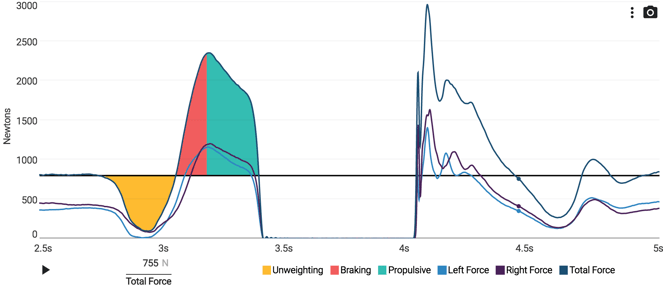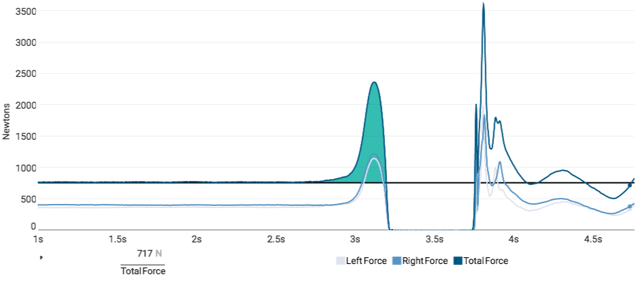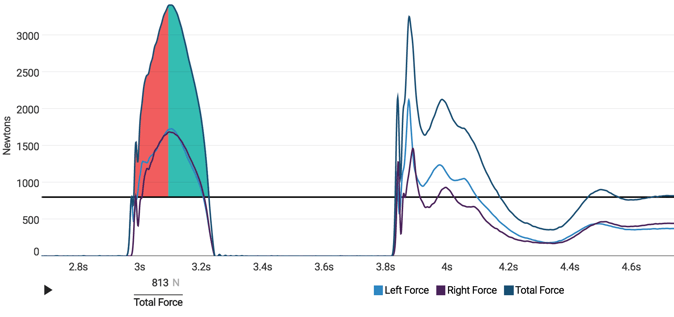This excerpt is from ZFlow Blog & a conversation with Dr. Jason Lake in June of 2016. Dr. Lake is a senior lecturer in Sport & Exercise Biomechanics at the University of Chichester in the UK. He is a leading researcher in force plate application. The topic of our conversation was jumping - specifically its value for evaluating athletes.
Dr. Jason Lake
Why do we measure jumping?
"It just seems so obvious," Dr. Lake responded, "but there are a number of very specific reasons for why we measure jumping - and different types of jumps at that. We implement static start countermovement and drop vertical jumping because they provide a controlled model that enables the study of an individual's ability to apply force during variations of lower-body triple extensions (hips, knees, and ankles)."
 Graph of a Countermovement Jump.
Graph of a Countermovement Jump.
What types of tests do you typically look at?
"Three tests provide us with a way of assessing very similar qualities under different biomechanical circumstances, and with different variables.
The squat jump (or static start jump) demonstrates the athlete's ability to rely on concentric force to displace body mass.
The countermovement jump - a slow stretch-shortening cycle movement - enables athletes to start using a more common or natural movement, i.e. they can utilize elastic energy (amongst other things) to maximize jump height.
The drop jump gives us a much better idea of how an individual can both react and respond to load while trying to maximize vertical displacement. Contrary to the CMJ, this one is a fast stretch-shortening cycle movement - the athlete is exposed to a violent landing force that has to be absorbed efficiently before the jump component can be attempted and (ideally) enhanced."
 Graph of a Squat Jump
Graph of a Squat Jump
What do you think are some of the challenges teams face when measuring jumping?
"Well, I'm a professor, so I don't have a lot of experience in a team setting. However, I do speak to a lot of coaches who use these types of tests, and the challenges are pretty straight forward: they're concerned about what jump types they should be using - a valid point, as different jumps can be more specific for different sports. They are concerned about how they are implementing jump testing into their process - as well as how often they should be testing, how many jumps their athletes perform in each test, and how to standardize the tests effectively. Furthermore, one of the larger variances I see relates to what technology is used to measure. At the end of the day, it can be pretty confusing - after determining the type of jump you want to measure, then how you're going to measure it, you then have to determine which variables are relevant to your program and your athletes."
 Graph of a Drop Jump
Graph of a Drop Jump
What are your thoughts on using jumping as a benchmark?
"Some teams use jump performance as a readiness to train metric. They would have guys come in in the morning, jump a few times, and over time generate a baseline. Subsequently, if the baseline value declines, trainers or coaches would ramp back the athletes' training loads. I have seen it used this way in the past, but I'm not sure how often it is used anymore, and it was always part of a battery of readiness to train tests."
"The three jump types I mentioned previously still stand for benchmarking. When going through the power phase in a training program, you should see an improvement typically expressed as the athlete is able to produce more force faster; and if you don't see an improvement, chances are something is off. To do this one might look at impulse and the force and time components that underpin it, to try to figure out where an athlete's weakness may lie. A significant portion of this depends on an athlete's training history, training age, status, gender, etc. However, if you identify jump tests performed well and consistently, there is no reason why you can't use them to provide benchmarks, and then use benchmarks to assess the effectiveness of training strategies."
Contact
If you'd like to get in touch with Dr. Lake, reach out to him on Twitter @ProfJLake
Check out Dr. Lake's ResearchGate profile here
Check out Dr. Lake on LinkedIn here
-2.png?width=156&height=60&name=Hawkin%20Logo%20(2)-2.png)
-1.png?width=155&height=60&name=WHITE.Horizontal_Logo.Transparent%20(3)-1.png)


